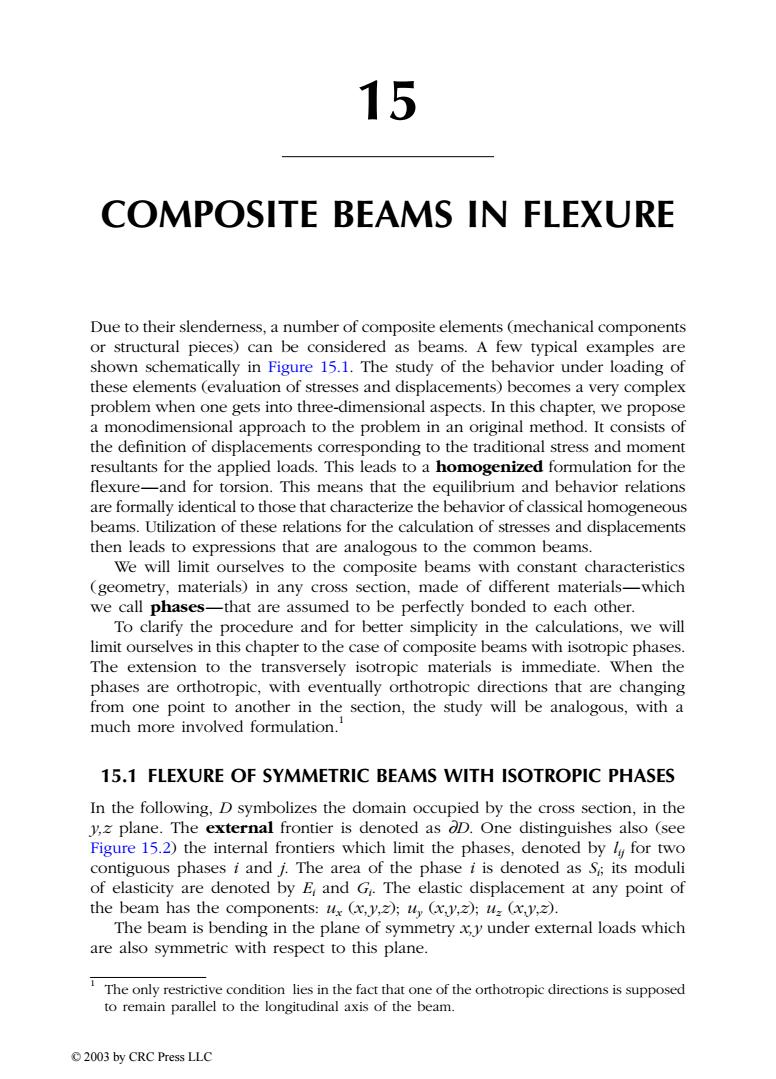正在加载图片...

15 COMPOSITE BEAMS IN FLEXURE Due to their slenderness,a number of composite elements(mechanical components or structural pieces)can be considered as beams.A few typical examples are shown schematically in Figure 15.1.The study of the behavior under loading of these elements (evaluation of stresses and displacements)becomes a very complex problem when one gets into three-dimensional aspects.In this chapter,we propose a monodimensional approach to the problem in an original method.It consists of the definition of displacements corresponding to the traditional stress and moment resultants for the applied loads.This leads to a homogenized formulation for the flexure-and for torsion.This means that the equilibrium and behavior relations are formally identical to those that characterize the behavior of classical homogeneous beams.Utilization of these relations for the calculation of stresses and displacements then leads to expressions that are analogous to the common beams. We will limit ourselves to the composite beams with constant characteristics (geometry,materials)in any cross section,made of different materials-which we call phases-that are assumed to be perfectly bonded to each other. To clarify the procedure and for better simplicity in the calculations,we will limit ourselves in this chapter to the case of composite beams with isotropic phases. The extension to the transversely isotropic materials is immediate.When the phases are orthotropic,with eventually orthotropic directions that are changing from one point to another in the section,the study will be analogous,with a much more involved formulation. 15.1 FLEXURE OF SYMMETRIC BEAMS WITH ISOTROPIC PHASES In the following,D symbolizes the domain occupied by the cross section,in the y,z plane.The external frontier is denoted as OD.One distinguishes also (see Figure 15.2)the internal frontiers which limit the phases,denoted by l for two contiguous phases i and j.The area of the phase i is denoted as S;its moduli of elasticity are denoted by E,and G.The elastic displacement at any point of the beam has the components:ux (x,y,2);u (x,y,2);u (x,y,z). The beam is bending in the plane of symmetry xy under external loads which are also symmetric with respect to this plane. The only restrictive condition lies in the fact that one of the orthotropic directions is supposed to remain parallel to the longitudinal axis of the beam. 2003 by CRC Press LLC15 COMPOSITE BEAMS IN FLEXURE Due to their slenderness, a number of composite elements (mechanical components or structural pieces) can be considered as beams. A few typical examples are shown schematically in Figure 15.1. The study of the behavior under loading of these elements (evaluation of stresses and displacements) becomes a very complex problem when one gets into three-dimensional aspects. In this chapter, we propose a monodimensional approach to the problem in an original method. It consists of the definition of displacements corresponding to the traditional stress and moment resultants for the applied loads. This leads to a homogenized formulation for the flexure—and for torsion. This means that the equilibrium and behavior relations are formally identical to those that characterize the behavior of classical homogeneous beams. Utilization of these relations for the calculation of stresses and displacements then leads to expressions that are analogous to the common beams. We will limit ourselves to the composite beams with constant characteristics (geometry, materials) in any cross section, made of different materials—which we call phases—that are assumed to be perfectly bonded to each other. To clarify the procedure and for better simplicity in the calculations, we will limit ourselves in this chapter to the case of composite beams with isotropic phases. The extension to the transversely isotropic materials is immediate. When the phases are orthotropic, with eventually orthotropic directions that are changing from one point to another in the section, the study will be analogous, with a much more involved formulation.1 15.1 FLEXURE OF SYMMETRIC BEAMS WITH ISOTROPIC PHASES In the following, D symbolizes the domain occupied by the cross section, in the y,z plane. The external frontier is denoted as ∂D. One distinguishes also (see Figure 15.2) the internal frontiers which limit the phases, denoted by lij for two contiguous phases i and j. The area of the phase i is denoted as Si ; its moduli of elasticity are denoted by Ei and Gi . The elastic displacement at any point of the beam has the components: ux (x,y,z); uy (x,y,z); uz (x,y,z). The beam is bending in the plane of symmetry x,y under external loads which are also symmetric with respect to this plane. 1 The only restrictive condition lies in the fact that one of the orthotropic directions is supposed to remain parallel to the longitudinal axis of the beam. TX846_Frame_C15 Page 283 Monday, November 18, 2002 12:30 PM © 2003 by CRC Press LLC